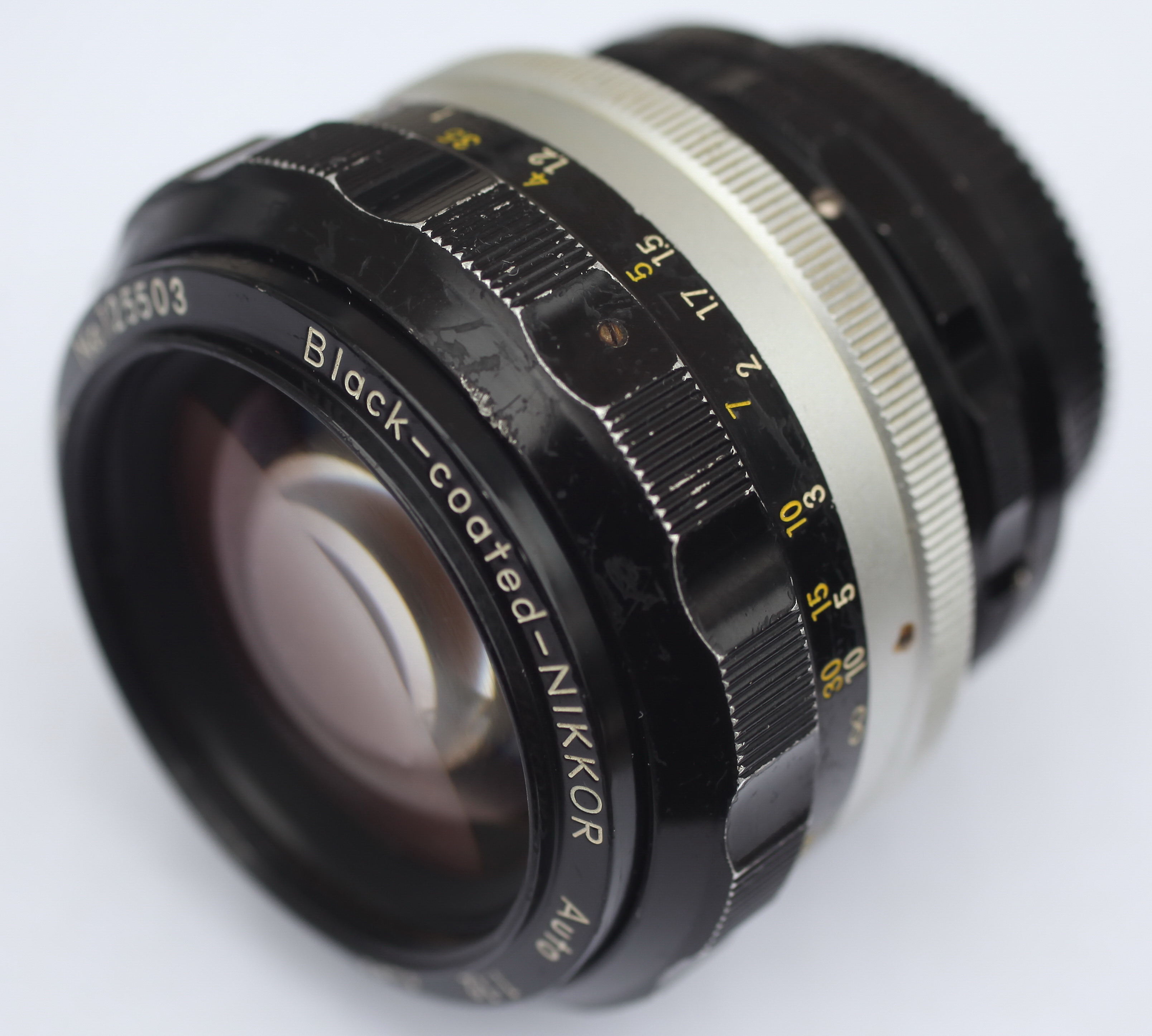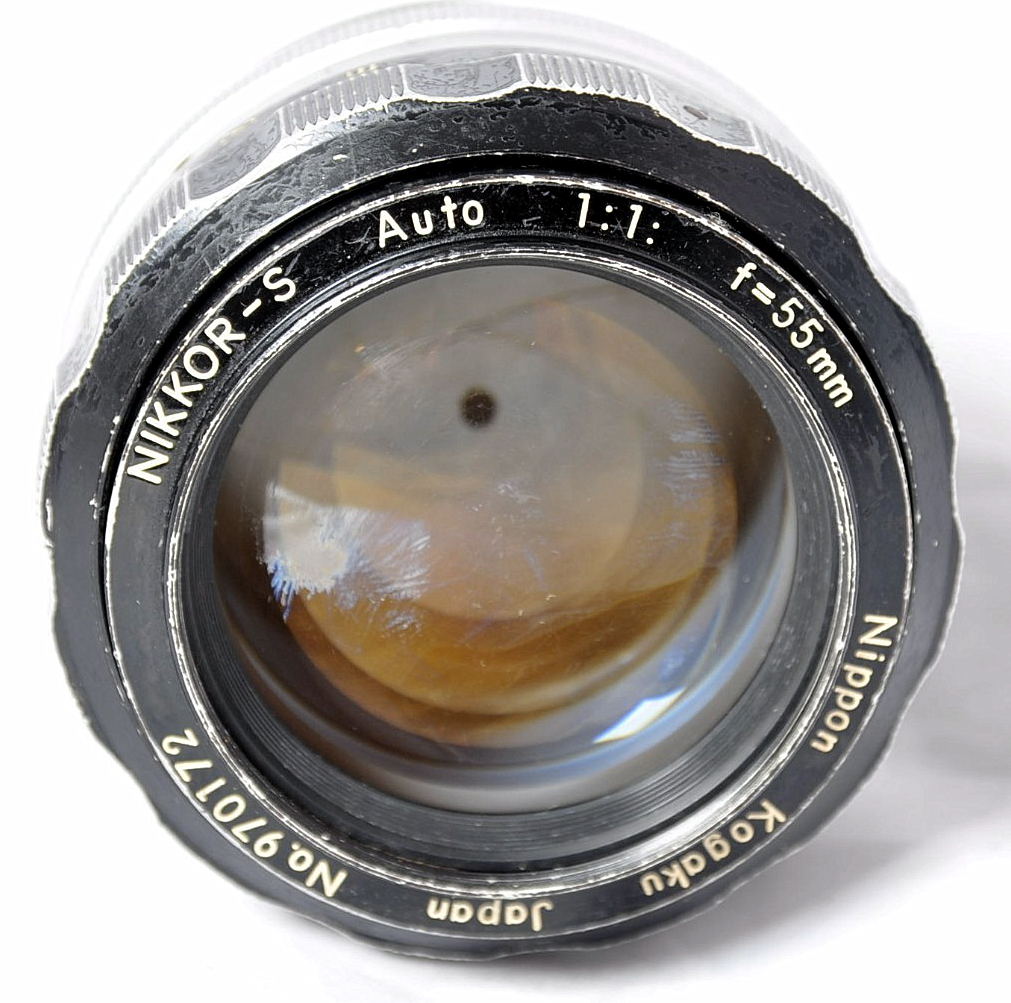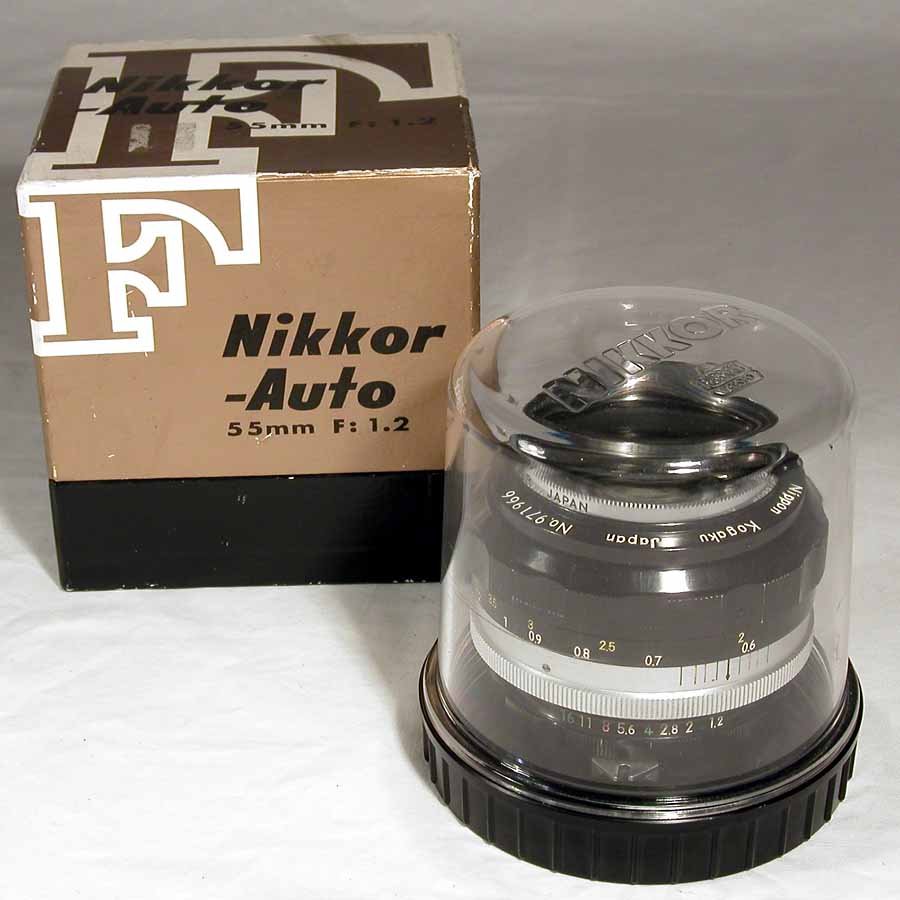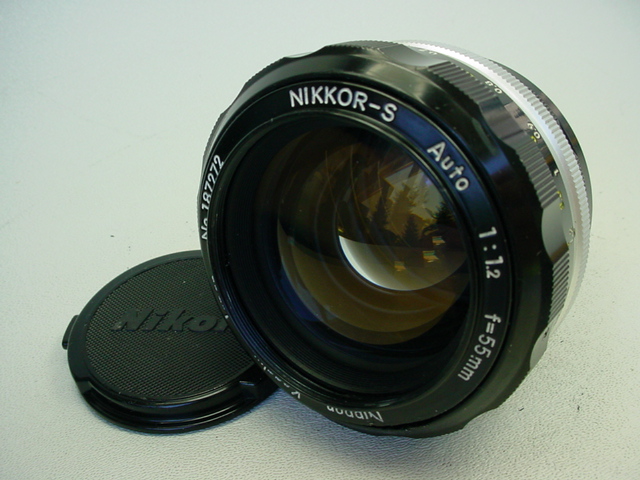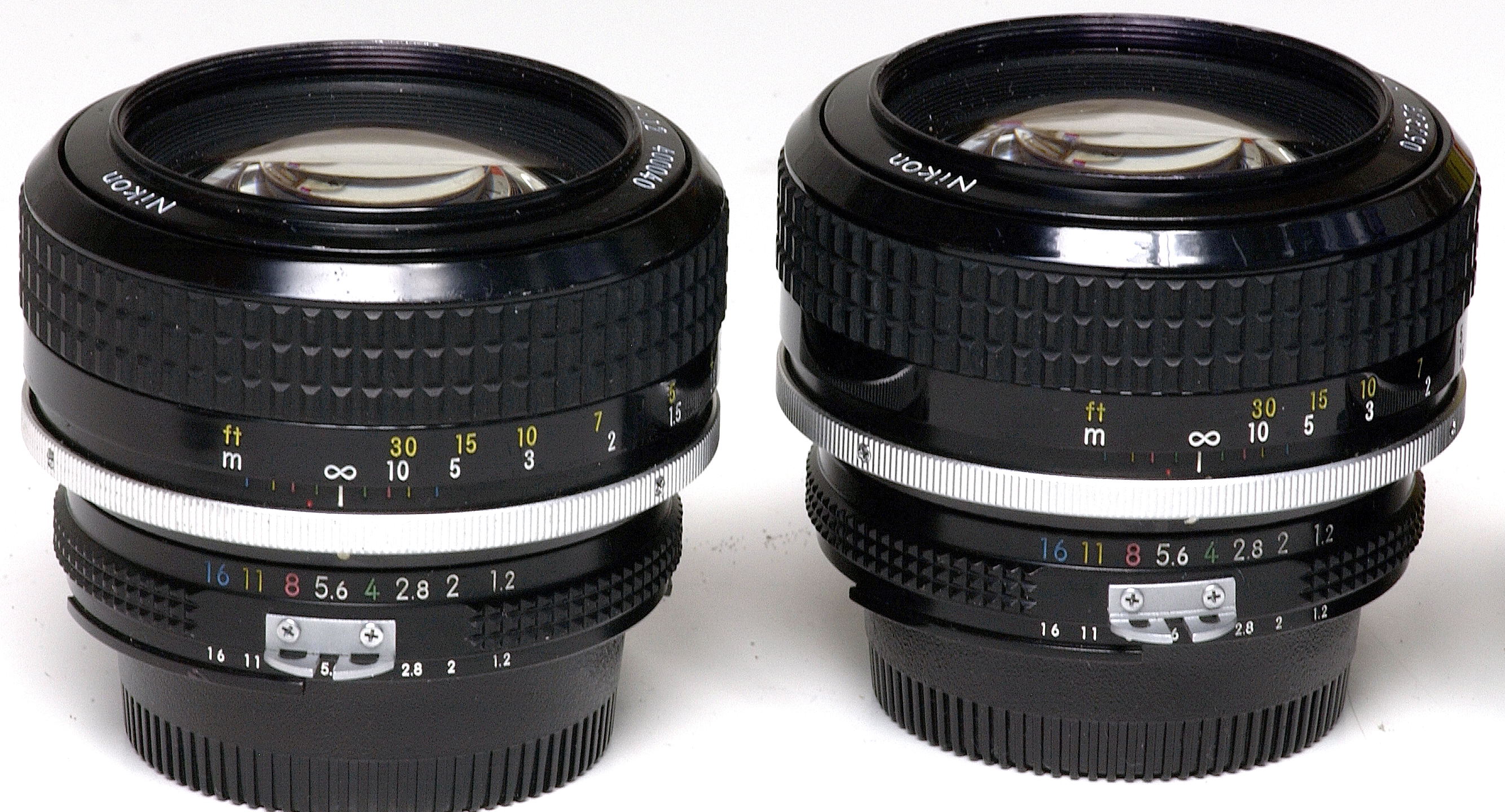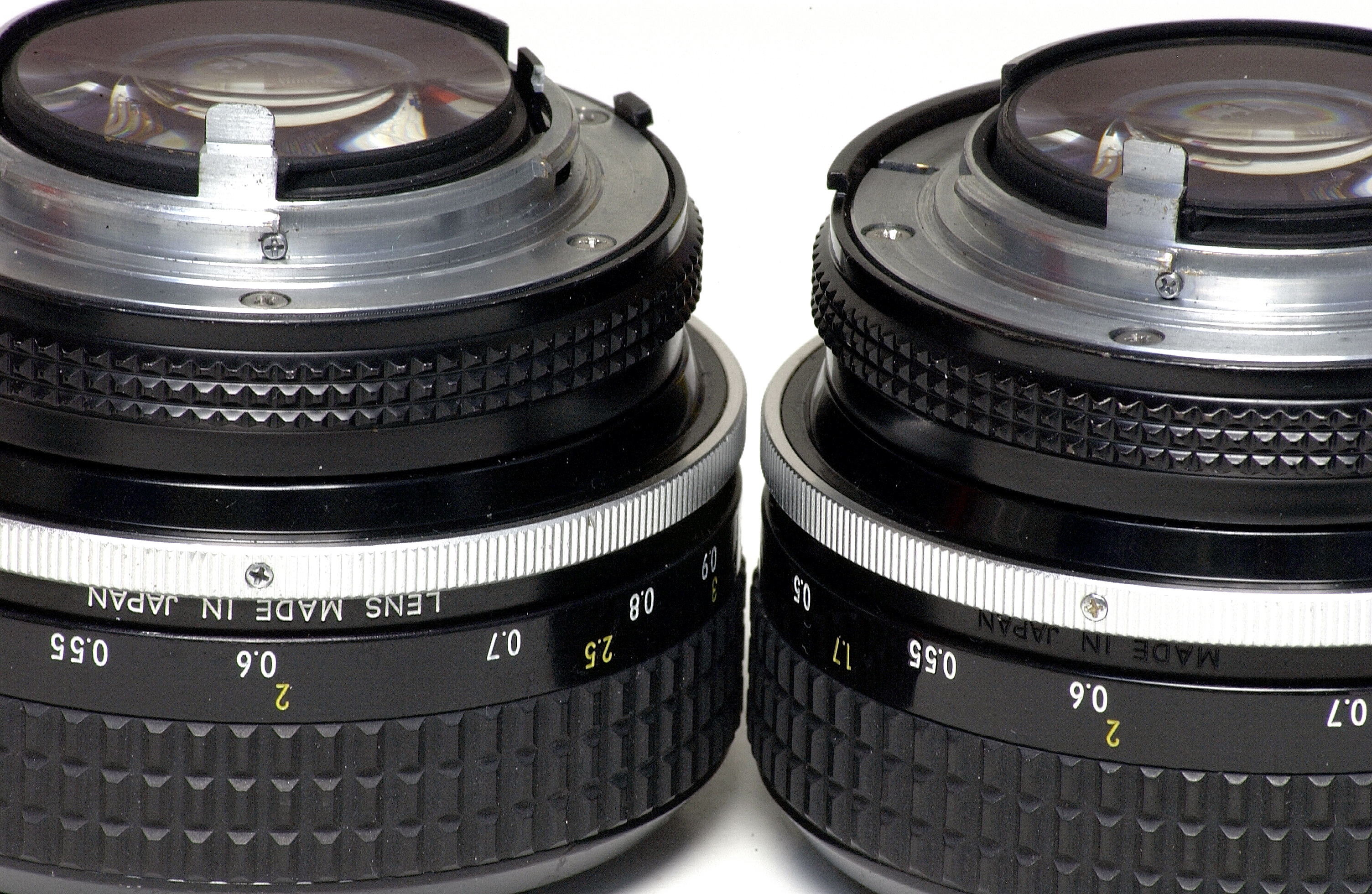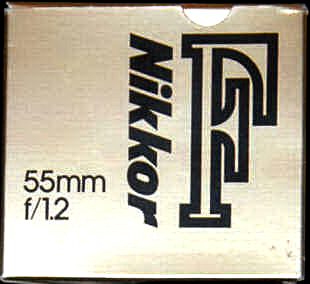Nikkor 1.2/55 mm. types/versions
Version 1
The very first version is probably a mockup, made by Nikon Corporation to show to the public in early 1965. In many contemporary books and magazines this lens is shown, but nobody has ever seen this lens in a shop and/or exhibition. The picture shown below is the very first image of this lens as published in 'The Nikkormat Handbook' by Cooper & Abbott , around 1965. Many other authors have made use of this image. The lens shown above may be a modified Nikkor-S 1.4/5.8 cm. as when this lens (especially the front element) would have the same size as the later production models, the filter size should be 60 mm. since the lens data are placed within the filter ring. The serial number suggests that more than one were made. The production version started at #970111.
A real prototype (not just a picture) is the above 'black-coated-Nikkor' with a serial number that suggests that there are at least two more around! The lens was probably used by a factory selected photographer to test the lens' features.
(photos courtesy A.T.) The black coating does not refer to a coating on the lens elements but on the lens body interior, as black coating was/is a high emissivity coating with extremely high absorptance and low reflectance. In fast lenses internal reflections may 'kill' images. Nikon may have tested that internal black coating together with the multi-layer coating on all glass-to-air surfaces of this lens; being the first Nikkor ever with that particular coating. The lens body equals the lens bodies of the final product. The serial number reflects the technical specifications of the lens and ..........suggests that there are maybe more lenses of that kind in existence. Who knows? Version 2
This is the 10th lens of the production batch/version!
This lens was introduced in December 1965 and sales started early 1966. Serial numbers are known from 970111 up into the 985xxx range. The all black painted metal lens barrel has a scalloped distance and aperture ring (carrying a triangular fork) with in between a chrome ring of 6 mm. width. This lens is assembled with (flat) slot screws, in the back plate three screws. The aperture ring can be removed by turning/screwing it counterclockwise after removing a small side screw and by lifting the back plate. Nikon proudly announced that this lens was one of the very first Nikkor lenses with a coating on all glass-to-air surfaces. Because the aperture ring has to be screwed off this ring cannot be exchanged by a later introduced AI-conversion ring. Many users therefore milled a part of the ring to use the lens on later Nikon AI-SLR bodies (see below).
The first 2,000 lenses have no groove (above left) in the aperture ring (between the scallops and the fork) and the ribs in the scalloped aperture ring are a bit larger (13 ribs in stead of 11); all later lenses have a scalloped ring with a groove (above right). Lens inscriptions in white letters on the front of the lens barrel outside the black (52 mm.) filter ring: NIKKOR-S Auto 1:1.2 f=55 mm Nippon Kogaku Japan No. xxxxxx. Distance indications: feet in yellow, meters in white. Aperture range: 16 (blue), 11 (yellow), 8 (pink), 5.6 - 2.8 - 2 and 1.2 in white. The lens weights in at 421 grams (without caps). This version was succeeded in November 1967 by version III. Total production in 2 years some 15,400 lenses.
Recently a lens of this version with a mis-engraving has been discovered: #970172 NIKKOR-S Auto 1:1: (see above)
When bought new the lens came in a plastic container with the Nippon Kogaku logo and 'Nikkor' on top. That container was placed in a two-piece box as shown in the image above. A small guarantee card was added but no lens chart nor an instruction sheet.
Version 3
This version was introduced in November 1967. At first sight there are no important changes, though the aperture ring can be lifted off after releasing a set screw at the side of the ring and lifting the back plate. This implies that from now on all versions can be adapted to the AI-coupling system. Nikon provided interchangeable rings to repairmen. Another change is the chrome ring, which is now 5 mm. wide. All letters on the lens barrel are a bit tinier than those on Version 2. All lenses were assembled with slot screws. Please do not ask why, but serial numbers are starting with - an incomprehensible - No. 184711.
In the #193xxx range (August 1968) the back plate is mounted with 5 slot screws in stead of three slot screws. (although #192153 has 5 screws, #192500 has still 3 screws!) During its production, which terminated mid 1972, Nikon changed the text on the name ring. No lenses have been found from 216000 up to 219999. The last lens known with the 'Nippon Kogaku Japan' inscription is #215731. Somewhere in the #213xxx range the triangular fork was replaced by a rounded fork.
Important changes were introduced on all lenses with serial numbers over 220001 (produced from August 1971). The optical formula was altered to improve the performance at close focus. The new lenses now bear the inscription 'Nikon'. 'No.' before the serial number disappears. Last known serial number - confirmed by the factory - #240533. All lenses in the 220001-240533 range also received a rounded fork (as shown above) Early lenses in the #19xxxx range came with a box identical to the box of the Version 2. Later lenses came with a new folding box with a insert made of polystyrene foam (see below). The boxes that came with the Nikkor S.C lenses have an additional C printed on their box.
Version 4
Production of this version started in October 1972. The lens looks like version 3 but now bears the inscription Nikkor S.C, where the C stands for a multi-layer coating. This lens has, indeed, an amber coating. On the name ring one can find 'Nikon' and the serial number without the preceding 'No.' The chrome ring is 6 mm. in width. The entire lens has been assembled with slot screws, although lenses from serial number 260001 - production started in June 1973 - have been assembled with cross screws (aka Phillips* screws), also 5 in the black plate. Serial numbers start with 250001 and the last recorded and factory confirmed serial number is 300556. *named after Henry F. Phillips (1890-1958), who invented this type of screw in 1934.
The S.C lenses came in a similar box as the Version 3 lenses, save the large black C on the side, indicating the special coating.
Version 5
This version of the lens came into production in April 1976. The entire lens barrel was redesigned. The scalloped barrel was replaced by a black painted flat barrel with rubber grip at the distance ring and a flat aperture ring. The closest focusing distance is 50 cm. mainly as a result of a minor change of the optical formula. The coating of this version was introduced as Super Integrated Coating. Its weight is 415 grams. The inscription on the front is: NIKKOR 55 mm 1:1.2 xxxxxx Nikon. All letters, in white, having the same size. The lens diameter is 72 mm., the overall length is 61 mm. (distance filter ring - mount is 49.5 mm.). Serial numbers start with 350011, which might imply that a few prototypes of this version exist. Last known serial number is within the 386xxx range. Many lenses of this version were sold with the common aperture ring, although some lenses could be ordered with the AI-ring (AI = aperture indexing; shown above), so that the lens could be used on the AI-mount cameras, introduced in July 1977. On one of the lens sheets, supplied with a new lens, one can see a lens with serial number 350011 having an AI-ring.
The Version 5 lenses were sold in a silver coloured box with an insert and with a lens sheet.
Version 6
This version is like Version 5 but adjusted in July 1977 for the AI-coupling system. The new diaphragm ring has a double line of aperture data. Those for the aperture direct readout are all of the same size and in white. The fork is an open type improving the readability of the aperture data in the viewfinder of most Nikon SLR bodies. On all lenses mentioned hereto on the side of the barrel one can find the inscription 'lens made in japan' in white letters. On the last batch of the lens Version 6 this inscription is replaced by a black 'made in japan'. The last batch also has a protective lid at the back flange. The production of this remarkable lens terminated in April 1978. Serial numbers start with 400001; last number known to the author is within the 425xxx range.
One very early (left) and one of the last known (right) #4-series
Early lenses had engravings like 'lens made in japan' in white, later lenses 'made in japan'in black.
The Version 6 lens came in a gold coloured box, similar to the Version 5 box.
The total production of all versions - in 12.5 years - will be somewhere around 172,250 lenses, which is quite a lot for such a fast and relatively expensive lens. This production number is surpassed by the (successor) Nikkor 1.2/50 mm. (over 230,000 lenses; in over 35 years, though). AI/S versions of this lens do not exist as the AI/S mount was introduced in September 1981.
|

